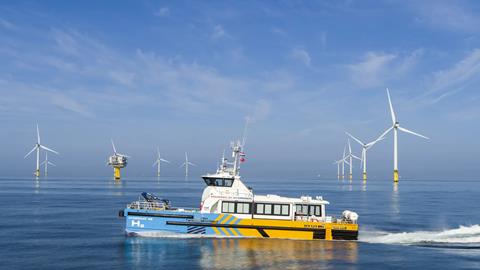The Netherlands’ first hydrogen bunker permit has been granted to Windcat Workboats so that the company can bunker the Hydrocat 48 crew transfer vessel (CTV) with hydrogen in the port of IJmuiden.
The Hydrocat 48 is powered by a dual-fuel solution, capable of being powered by hydrogen in a combination with marine gas oil. To achieve this, the vessel’s MAN dual-fuel engine was retrofitted with a hydrogen injection system by CMB.TECH.
A hydrogen bunker permit has been granted to Windcat Workboats so that the company can bunker the Hydrocat 48 crew transfer vessel (CTV) with hydrogen in the port of IJmuiden.
The operating behaviour, fuel consumption and all other characteristics correspond exactly to the MAN D2862 LE428 with the same performance. In a form of pre-treatment, a precisely measured quantity of hydrogen is added to the charge air. This mixture of hydrogen and air is then ignited with the injected diesel fuel in the combustion chamber of the cylinders. Depending on the engine’s operating point, only a very small amount of diesel fuel is needed. The diesel injection parameters are optimised in dual fuel mode to achieve the lowest emissions and the best consumption values. Therefore, in dual fuel mode, considerably less CO2 is released in the exhaust gases in circumstances where operating behaviour and full load characteristics remain unchanged.
“The suitability of this technology for a CTV is mainly because existing diesel engines can be used,” says Roy Campe, CTO of CMB.TECH. “No fundamental changes to the main engine are required, which not only means that maintenance and repair remain simple, but also that the engine can easily be switched back to diesel fuel without any modifications. Even if hydrogen is not available, the vessel can continue to run on traditional fuel, making it a very robust and reliable solution for the offshore wind industry.”
Windcat Workboats, together with the IJmond Environment Agency, Zeehaven IJmuiden NV and Port of Amsterdam, investigated what was needed to make the bunkering of hydrogen possible. Environment Agency IJmond then granted an environmental permit on behalf of the municipality of Velsen.
The vessel is now deployed to support the maintenance of 44 Vestas turbines in the Belgian wind farm Norther.
Windcat Workboats owns and operates, directly or through its joint ventures, a fleet of 46 CTVs in the European offshore wind sector. Windcat, together with its joint venture partners TSM and FRS, has three more vessels under construction that can be delivered with the hydrogen technology on board. More CTV designs using this technology are being developed.
“This license represents a major step in the possibility to use hydrogen as a fuel for vessels and increasing the sustainability of the sector,” said Willem van der Wel, managing director of Windcat Workboats. “As bunkering hydrogen for shipping is a new development, the licensing process was quite complex. With the first license now approved we expect the use of hydrogen as a green fuel to accelerate.”
SEACOR Marine and CMB recently acquired Windcat Workboats.






